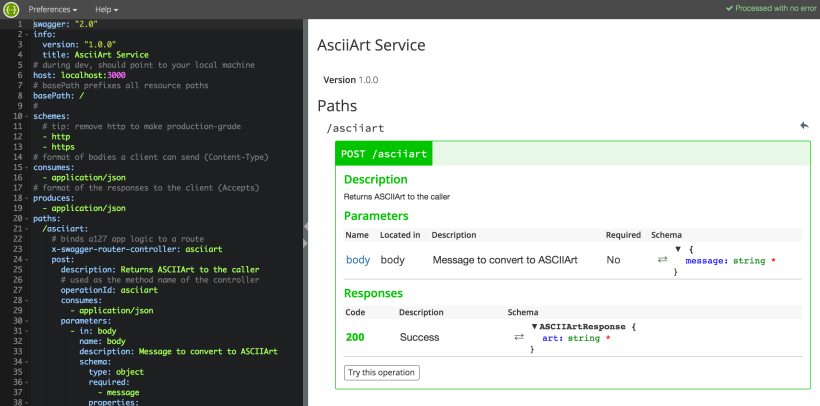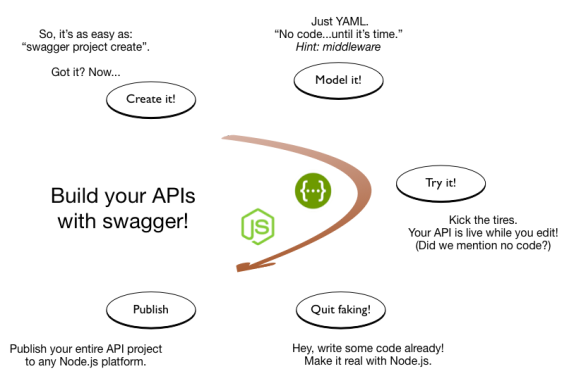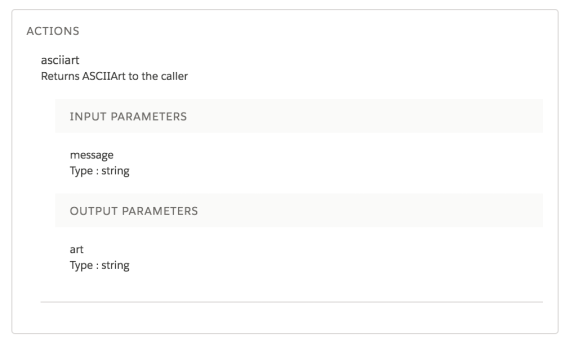In my previous blog i covered an exciting new integration tool from Salesforce, which consumes API’s that have a descriptor (or schema) associated with them. External Services allows point and click integration with API’s. The ability for Salesforce to consume API’s complying with API schema standards is a pretty huge step forward. Extending its ability to integrate with ease in a way that is in-keeping with its low barrier to entry development and clicks not code mantra.

At the time of writing my previous blog, only Interagent schema was supported by External Services. However as of the Winter’18 release this is no longer the case. In this blog i will explore the more widely adopted Swagger / Open API 2.0 standard, using Node.js and Heroku and External Services. As bonus topic, i will also touch on using Swagger Code Generator with Apex!
One of the many benefits of supporting the Swagger / Open API standard is the ability to generate documentation for it. The following screenshot shows the API schema on the left and generated documentation on the right. What is also very cool about this, is the Try this operation button. Give it a try for yourself now!


Whats the difference between Swagger and Open API 2.0? This was a question i asked myself and thought i would cover the answer here. Basically as at, Swagger v2.0, there is no difference, the Open API Initiative is a rebranding, born out of the huge adoption Swagger has seen since its creation. This move means its future is more formalised and seems to have more meaningful name. You can read more about this amazing story here.
Choosing your methodology for API development
The schema shown above might look a bit scary and you might well want to just get writing code and think about the schema when your ready to share your API. This is certainly supported and there are some tools that support generation of the schema via JSDoc comments in your code or via your joi schema here (useful for existing API’s).
However to really embrace an API first strategy in your development team i feel you should start with the requirements and thus the schema first. This allows others in your team or the intended recipients to review the API before its been developed and even test it out with stub implementations. In my research i was thus drawn to Swagger Node, a tool set, donated by ApiGee, that embraces API-design-first. Read more pros and cons here. It is also the formal Node.js implementation associated with Swagger.
The following describes the development process of API-design-first.

(ref: Swagger Node README)
Developing Open API’s with “Swagger Node”
Swagger Node is very easy to get started with and is well documented here. It supports the full API-design-first development process show in the diagram above. The editor (also shown above) is really useful for getting used to writing schemas and the UI is dynamically refreshed, including errors.
The overall Node.js project is still pretty simple (GitHub repo here), now consisting of three files. The schema is edited in YAML file format (translated to JSON when served up to tools). The schema for the ASCIIArt service now looks like the following and is pretty self describing. For further documentation on Swagger / Open API 2.0 see here.
https://createasciiart.herokuapp.com/schema/
swagger: "2.0"
info:
version: "1.0.0"
title: AsciiArt Service
# during dev, should point to your local machine
host: localhost:3000
# basePath prefixes all resource paths
basePath: /
#
schemes:
# tip: remove http to make production-grade
- http
- https
# format of bodies a client can send (Content-Type)
consumes:
- application/json
# format of the responses to the client (Accepts)
produces:
- application/json
paths:
/asciiart:
# binds a127 app logic to a route
x-swagger-router-controller: asciiart
post:
description: Returns ASCIIArt to the caller
# used as the method name of the controller
operationId: asciiart
consumes:
- application/json
parameters:
- in: body
name: body
description: Message to convert to ASCIIArt
schema:
type: object
required:
- message
properties:
message:
type: string
responses:
"200":
description: Success
schema:
# a pointer to a definition
$ref: "#/definitions/ASCIIArtResponse"
/schema:
x-swagger-pipe: swagger_raw
# complex objects have schema definitions
definitions:
ASCIIArtResponse:
required:
- art
properties:
art:
type: string
The entry point of the Node.js app, the server.js file now looks like this…
'use strict';
var SwaggerExpress = require('swagger-express-mw');
var app = require('express')();
module.exports = app; // for testing
var config = {
appRoot: __dirname // required config
};
SwaggerExpress.create(config, function(err, swaggerExpress) {
if (err) { throw err; }
// install middleware for swagger ui
app.use(swaggerExpress.runner.swaggerTools.swaggerUi());
// install middleware for swagger routing
swaggerExpress.register(app);
var port = process.env.PORT || 3000;
app.listen(port);
});
Note: I changed the Node.js web server framework from hapi (used in my previous blog) to express. As I could not get the Swagger UI to integrate with hapi.
The code implementing the API has been moved to its asciiart.js file.
var figlet = require('figlet');
function asciiart(request, response) {
// Call figlet to generate the ASCII Art and return it!
const msg = request.body.message;
figlet(msg, function(err, data) {
response.json({ art: data});
});
}
module.exports = {
asciiart: asciiart
};
Note: There is no parameter validation code written here, the Swagger Node module dynamically implements parameter validation for you (based on what you define in the schema) before the request reaches your code! It also validates your responses.
To access the documentation simply use the path /docs. The documentation is generated automatically, no need to manage static HTML files. I have hosted my sample AsciiArt service in Heroku so you can try it by clicking the link below.
https://createasciiart.herokuapp.com/docs/

Consuming Swagger API’s with External Services
The process described in my earlier blog for using the above API via External Services has not changed. External Services automatically recognises Swagger API’s.

NOTE: There is a small bug that prevents the callout if the basePath is specified as root in the schema. Thus this has been commented out in the deployed version of the schema for now. Salesforce will likely have fixed this by the time you read this.
Swagger Tools
 Swagger Editor, the interactive editor shown in the first screenshot of this blog.
Swagger Editor, the interactive editor shown in the first screenshot of this blog.- Swagger Code Generator, creates server stubs and clients for implementing and calling Swagger enabled API’s.
- Swagger UI, the browser based UI for generating documentation. You can call this from the command line and upload the static HTML files or use frameworks like the one used in this blog to generated it on the fly.
Can we use Swagger to call or implement API’s authored in Apex?
Swagger Tools are available on a number of platforms, including recently added support for Apex clients. This gives you another option to consume API’s directly in Apex. Its not clear if this is going to a better route than consuming the classes generated by External Services, i suspect it might have some pros and cons tbh. Time will tell!
Meanwhile i did run the Swagger Code Generator for Apex and got this…
public class SwagDefaultApi {
SwagClient client;
public SwagDefaultApi(SwagClient client) {
this.client = client;
}
public SwagDefaultApi() {
this.client = new SwagClient();
}
public SwagClient getClient() {
return this.client;
}
/**
*
* Returns ASCIIArt to the caller
* @param body Message to convert to ASCIIArt (optional)
* @return SwagASCIIArtResponse
* @throws Swagger.ApiException if fails to make API call
*/
public SwagASCIIArtResponse asciiart(Map<String, Object> params) {
List<Swagger.Param> query = new List<Swagger.Param>();
List<Swagger.Param> form = new List<Swagger.Param>();
return (SwagASCIIArtResponse) client.invoke(
'POST', '/asciiart',
(SwagBody) params.get('body'),
query, form,
new Map<String, Object>(),
new Map<String, Object>(),
new List<String>{ 'application/json' },
new List<String>{ 'application/json' },
new List<String>(),
SwagASCIIArtResponse.class
);
}
}
The code is also generated in a Salesforce DX compliant format, very cool!

October 1, 2017 at 4:56 pm
Where does SwagClient come from? Some Googling lead me to to Swagger Petstore API Client repo for Apex. (https://github.com/swagger-api/swagger-codegen/tree/master/samples/client/petstore/apex/force-app/main/default/classes)
October 3, 2017 at 3:01 pm
It’s generated by the tool
October 18, 2018 at 3:23 am
Hi Andrew,
We have a requirement to call Swagger API from Apex classes since we need to write re-try logic etc.
I have downloaded swagger-codegen-cli-2.2.1 jar and trying to generate the apex code. I am trying to run below command:
java -jar swagger-codegen-cli-2.2.1.jar generate -i https://createasciiart.herokuapp.com/schema/ -l Apex
but receiving below issue
Exception in thread “main” java.lang.RuntimeException: Can’t load config class with name Apex Available
but when I tried
java -jar swagger-codegen-cli-2.2.1.jar generate -i https://createasciiart.herokuapp.com/schema/ -l Java everything is okay, stub got created.
Can you help me how you generated Apex stub?
Thanks in advance.
Sushil
December 15, 2018 at 1:02 pm
I’ve not much experience with that tool tbh and not seen that error before. I did have a quick look for it in their issues list here https://github.com/swagger-api/swagger-codegen/issues but did not see a match. I’m afraid i don’t quite have the bandwidth at this time to dig deeper for you, but hopefully if you raise an issue on the repo for the tool itself you can get a response and/or twitter? https://github.com/swagger-api/swagger-codegen/issues
Pingback: Simplified API Integrations with External Services | Andy in the Cloud
Pingback: Around the Web – 20171006 - WIP Developer.com
Pingback: Adding Clicks not Code Extensibility to your Apex with Lightning Flow | Developer Force Blog
Pingback: Adding Clicks not Code Extensibility to your Apex with Lightning Flow | Andy in the Cloud
May 23, 2018 at 11:14 pm
Nice article!
I am using Swagger-JSdoc to generate swagger.json at run time. But Salesforce External Services throwing error as they need json to be in Interagent format. Could you please put some light on that?
June 3, 2018 at 8:36 am
It’s hard to say without knowing the error. I know that external services now support swagger as well though
September 10, 2018 at 10:07 pm
Nice one,
Is there a way to use the swagger module entirely in Apex?
There is swagger-node to design and build API in Node.js, so question is there any way to use swagger to design, build Apex Rest API?
If you have any regarding experience, could you pls share with us. We have many custom rest API designed in Apex, so we want to use a tool to manage and also to have a well design document.
Thanks,
December 15, 2018 at 1:41 pm
Thats a really good plan. Sadly though it seems Apex is only supported when generating client code at the moment as i don’t see it listed in the “Server stubs” languages in the README. https://github.com/swagger-api/swagger-codegen. Perhaps you can request or contribute an enhancement! That would be very cool!
Pingback: Swagger / Open API + Salesforce = LIKE – Kay Scott's Blog
March 22, 2019 at 6:54 am
Hi, I want to send dynamic value in http header from flow. How to achieve that in schema?
April 4, 2019 at 5:55 pm
As far as I know it only exposes operation parameters to flow. But named Credentials does have some ability to map things to http headers maybe that will help?
Pingback: Tools | Andy in the Cloud – Kay Scott's Blog
Pingback: External Services | Andy in the Cloud – Kay Scott's Blog
Pingback: Salesforce Sphere - September Round Up of the Top Blog Posts! - Salesforce Ben
September 30, 2020 at 2:48 pm
Trying to install swagger codegen on a windows 10 laptop but getting lots of errors. Windows 10 doesn’t come with IIS installed to start with. When I start up the tool, I get an error with localhost:8080. I got IIS installed so localhost works but I can’t figure out where in the distribution to point the port at.
Also wget tries to use TLS 1 but the github doesn’t support anymore. I tried to find a newer version of wget but can’t find one in an msi package to install properly.
December 31, 2020 at 9:02 pm
Sorry David – i am not a Windows user so cannot try this. I recommend you post on the Swagger site / github pages for help here.
January 29, 2021 at 11:06 am
Good article. Do you know if there is any generation for APEX API Class to Swagger?
February 6, 2021 at 12:07 pm
No I am not aware of that – you would have to other the swagger for your apex rest api class yourself. Would be an interesting open source project though – since the apex parser is available
August 30, 2021 at 1:28 am
You can use Swagger Hub to generate the Apex classes with specific Swagger API. json
Pingback: Extend Flows with Heroku Compute: An Event-Driven Pattern